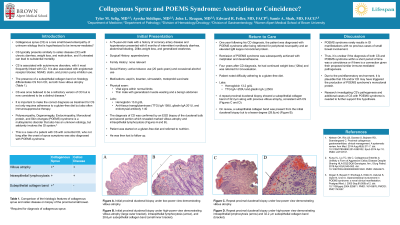Back


Poster Session B - Monday Morning
Category: Small Intestine
B0655 - Collagenous Sprue and POEMS Syndrome: Association or Coincidence?
Monday, October 24, 2022
10:00 AM – 12:00 PM ET
Location: Crown Ballroom

Has Audio

Tyler M. Selig, MD
Warren Alpert Medical School of Brown University
Providence, RI
Presenting Author(s)
Tyler M. Selig, MD1, Ayesha Siddique, MD2, John L. Reagan, MD3, Edward Feller, MD, FACG1, Samir A. Shah, MD, FACG4
1Warren Alpert Medical School of Brown University, Providence, RI; 2Brown University, Providence, RI; 3The Warren Alpert Medical School of Brown University, Providence, RI; 4Warren Alpert Medical School / The Miriam Hospital, Providence, RI
Introduction: We present a case of collagenous sprue (CS), a rare enteropathy of unknown etiology with subsequent diagnosis of POEMS syndrome, another rare entity and speculate on an association. CS typically presents similarly to celiac disease (CD) with chronic diarrhea, weight loss, and malnutrition. CS is most frequently associated with CD, and if untreated can lead to substantial mortality. The presence of a subepithelial collagen band (SCB) on histology differentiates CS from CD, as both have villous atrophy. Polyneuropathy, Organomegaly, Endocrinopathy, Monoclonal protein, and Skin changes syndrome (POEMS) presented shortly after this patient’s sprue symptoms, suggesting a possible association through an immune-mediated mechanism.
Case Description/Methods: A 75-year-old male with coronary artery disease and hypertension reported intermittent diarrhea, bloating, and 20lbs weight loss over six months. He had no relevant family history. His medications included losartan and aspirin. Physical exam was notable for a thin male (BMI 23.3) with a benign abdomen. His hemoglobin was 13.8 g/dL. CD serologies (anti-tissue transglutaminase IgA 158U, gliadin IgA 201U, and endomysial antibody 1:40) were positive; CD diagnosis was confirmed by an EGD biopsy of the proximal duodenum which revealed villous atrophy and intraepithelial lymphocytosis (Figure A). He was started on a gluten-free diet but did not follow up.
One year following his CD diagnosis, the patient was diagnosed with POEMS after being referred for peripheral neuropathy and an elevated IgM kappa monoclonal protein. Remission was achieved with melphalan and dexamethasone. Four years after initial CD diagnosis, he had continued weight loss (12lbs) and was referred for GI evaluation. A repeat duodenal biopsy showed a SCB of 32.2μm along with previous villous atrophy, consistent with CS (Figures B and C). On review, a SCB was present from the initial duodenal biopsy but to a lesser degree (28.6μm).
Discussion: POEMS rarely results in GI manifestations with no previous cases of small bowel involvement. Thus, it is unclear if the diagnosis of both CS and POEMS within a short period of time was a coincidence or if there is a connection given their proposed similar immune-mediated pathogenesis. Due to the proinflammatory environment, it is plausible that CS and/or CD may be triggering the production of POEMS’ monoclonal protein. Research investigating CS’s pathogenesis and additional cases of CS with POEMS is needed to further support this hypothesis.

Disclosures:
Tyler M. Selig, MD1, Ayesha Siddique, MD2, John L. Reagan, MD3, Edward Feller, MD, FACG1, Samir A. Shah, MD, FACG4. B0655 - Collagenous Sprue and POEMS Syndrome: Association or Coincidence?, ACG 2022 Annual Scientific Meeting Abstracts. Charlotte, NC: American College of Gastroenterology.
1Warren Alpert Medical School of Brown University, Providence, RI; 2Brown University, Providence, RI; 3The Warren Alpert Medical School of Brown University, Providence, RI; 4Warren Alpert Medical School / The Miriam Hospital, Providence, RI
Introduction: We present a case of collagenous sprue (CS), a rare enteropathy of unknown etiology with subsequent diagnosis of POEMS syndrome, another rare entity and speculate on an association. CS typically presents similarly to celiac disease (CD) with chronic diarrhea, weight loss, and malnutrition. CS is most frequently associated with CD, and if untreated can lead to substantial mortality. The presence of a subepithelial collagen band (SCB) on histology differentiates CS from CD, as both have villous atrophy. Polyneuropathy, Organomegaly, Endocrinopathy, Monoclonal protein, and Skin changes syndrome (POEMS) presented shortly after this patient’s sprue symptoms, suggesting a possible association through an immune-mediated mechanism.
Case Description/Methods: A 75-year-old male with coronary artery disease and hypertension reported intermittent diarrhea, bloating, and 20lbs weight loss over six months. He had no relevant family history. His medications included losartan and aspirin. Physical exam was notable for a thin male (BMI 23.3) with a benign abdomen. His hemoglobin was 13.8 g/dL. CD serologies (anti-tissue transglutaminase IgA 158U, gliadin IgA 201U, and endomysial antibody 1:40) were positive; CD diagnosis was confirmed by an EGD biopsy of the proximal duodenum which revealed villous atrophy and intraepithelial lymphocytosis (Figure A). He was started on a gluten-free diet but did not follow up.
One year following his CD diagnosis, the patient was diagnosed with POEMS after being referred for peripheral neuropathy and an elevated IgM kappa monoclonal protein. Remission was achieved with melphalan and dexamethasone. Four years after initial CD diagnosis, he had continued weight loss (12lbs) and was referred for GI evaluation. A repeat duodenal biopsy showed a SCB of 32.2μm along with previous villous atrophy, consistent with CS (Figures B and C). On review, a SCB was present from the initial duodenal biopsy but to a lesser degree (28.6μm).
Discussion: POEMS rarely results in GI manifestations with no previous cases of small bowel involvement. Thus, it is unclear if the diagnosis of both CS and POEMS within a short period of time was a coincidence or if there is a connection given their proposed similar immune-mediated pathogenesis. Due to the proinflammatory environment, it is plausible that CS and/or CD may be triggering the production of POEMS’ monoclonal protein. Research investigating CS’s pathogenesis and additional cases of CS with POEMS is needed to further support this hypothesis.

Figure: Figure A. Initial proximal duodenal biopsy under high-power view demonstrating villous atrophy (large outer bracket), intraepithelial lymphocytosis (arrow), and 28.6um subepithelial collagen band (small inner bracket).
Figure B. Repeat proximal duodenal biopsy under low-power view demonstrating villous atrophy.
Figure C. Repeat proximal duodenal biopsy under high-power view demonstrating intraepithelial lymphocytosis (arrow) and 32.2um subepithelial collagen band (bracket).
Figure B. Repeat proximal duodenal biopsy under low-power view demonstrating villous atrophy.
Figure C. Repeat proximal duodenal biopsy under high-power view demonstrating intraepithelial lymphocytosis (arrow) and 32.2um subepithelial collagen band (bracket).
Disclosures:
Tyler Selig indicated no relevant financial relationships.
Ayesha Siddique indicated no relevant financial relationships.
John Reagan: Bristol Myers – Advisory Committee/Board Member. Pfizer – Grant/Research Support. Rigel – Advisory Committee/Board Member.
Edward Feller indicated no relevant financial relationships.
Samir Shah indicated no relevant financial relationships.
Tyler M. Selig, MD1, Ayesha Siddique, MD2, John L. Reagan, MD3, Edward Feller, MD, FACG1, Samir A. Shah, MD, FACG4. B0655 - Collagenous Sprue and POEMS Syndrome: Association or Coincidence?, ACG 2022 Annual Scientific Meeting Abstracts. Charlotte, NC: American College of Gastroenterology.
